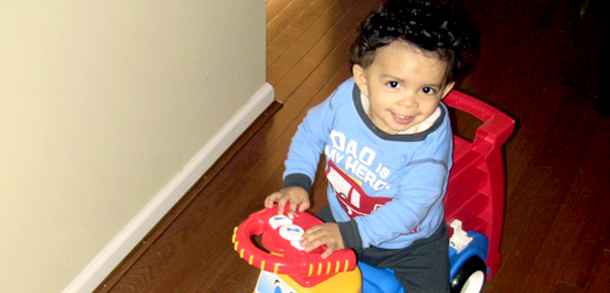The photo above is of my son, Hector, wearing a Mehta Cast, the non-invasive corrective treatment that our family chose for Hector when he was diagnosed with idiopathic infantile scoliosis. You may be wondering why we would CHOOSE such a thing and how in the world we managed a cast that covered his entire torso and couldn’t be removed. We wondered these things at first too, but really it wasn’t as bad as we thought it would be.
Our son’s journey with idiopathic infantile scoliosis – sometimes called infantile scoliosis or early onset scoliosis – started in November 2010. He had just turned one. His daycare teacher was the first to notice the curve in his spine while she was changing his shirt one day. I mentioned it to the pediatrician during his 12-month check-up and we talked about how rare scoliosis is in young children. Despite its rarity, she consulted with a physician at Cincinnati Children’s about the possibility of early onset scoliosis and ordered an x-ray that same day. It confirmed the diagnosis.
Within two weeks we had an appointment with Dr. Sturm. He recommended Mehta Casting, a new therapy at Cincinnati Children’s, for Hector. We felt lucky to have the option of a non-invasive therapy, but were worried about how we were going to manage every-day baby things with Hector in the cast.
With Hector’s first Mehta cast, it was trial and error as we figured out what would work for us. We relied on other parents and online support groups for tips on what to do with this bulky vest that our guy was now wearing — a bulky vest he would have to wear 24 hours a day for eight weeks.
Each cast weighed between three and four pounds. It was quite a shock to hold him for the first time. But after the learning curve of the first cast, we adapted pretty quickly.
Our first challenge was figuring out how to fit him in a car seat. We found advice through online support groups, which recommended the Britax car seat and the Safety 1st Alpha Omega convertible car seat. We found that the flexibility of a convertible car seat, regardless of the brand, was more comfortable for Hector.
When we got home that first day, Hector was still groggy from the anesthesia. Once it completely wore off, he tried to act like a normal one-year-old. Believe it or not, he had learned to walk just a couple of weeks before receiving the cast, and it was difficult to watch him learn to balance, fall, and walk all over again. But by the second cast, he had mastered walking and even climbing!
We learned that because every cast and every kid is different, the Mehta cast needed to be adjusted to keep Hector comfortable. When we noticed that Hector could not sit properly or move his neck, we contacted Cincinnati Children’s, where they trimmed, flared, and padded the cast.
The biggest challenges we faced every day were related to keeping the Mehta cast dry. Bathing and diapering were especially difficult. For baths, it took two of us. We sat him on the edge of the sink. One of us made sure he did not splash the water and the other gave Hector a sponge bath. Shampooing his hair was quite a scene. We used Bumkins’ oversized bibs with velcro closures —it looked like a hair salon cape! We had to lay him down and wash his hair quickly in order to keep him from getting the cast wet.
Diapering was particularly frustrating. The cast was quite tight on the bottom edge; we had to tuck both the front and back of the diaper under the bottom edge of the cast. Accidents were almost inevitable, but we were dedicated to becoming experts in order to prevent them! When accidents did happen, cleaning the cast with a soft detergent and drying with a hair drier usually did the trick.
Related to keeping his cast clean, no matter how diligent we were at avoiding the obvious locations and situations where small items could get inside of his cast, we would still find random things like cheerios in there! We did, however, stay away from playgrounds as it was too easy for sand, gravel, and mulch to get into the cast.
Despite all of the challenges related to the cast, we were always in awe seeing our little boy thrive. He didn’t mind bending or kneeling down in a modified way. He danced, jumped and ran without a care. His resilience is what kept us going. After six months of wearing a Mehta cast, Hector’s curve went from 35 degrees to around 10 degrees. At that point, instead of a cast, he started wearing a brace for 22 hours a day. We were all excited about his two hours of freedom. Life with a brace was a lot easier but we doubted the efficacy of it. Just four months after moving on to a brace, Hector’s curve corrected even more, down to six degrees. By July 2012, one year after he started wearing the brace, his spine was completely straight, and while it has since regressed ever so slightly, we are not at all worried about the small curve that he has today.
It’s been two years since we started this journey with Mehta casting. Everything now seems like a distant memory. But seeing Hector thrive and grow up healthy is our constant reminder of the wonderful people that helped us along the way. We are forever thankful for Cincinnati Children’s and their drive to be one of the best in the nation and for bringing Mehta casting to Cincinnati Children’s. We are also thankful for Dr. Sturm and his staff for being on our side and their commitment to setting scoliosis straight!







We are very proud of our little Hector, and how his parents and sister have help him along each step of this journey. Hopefully, other families can benefit from Hector’s experience.